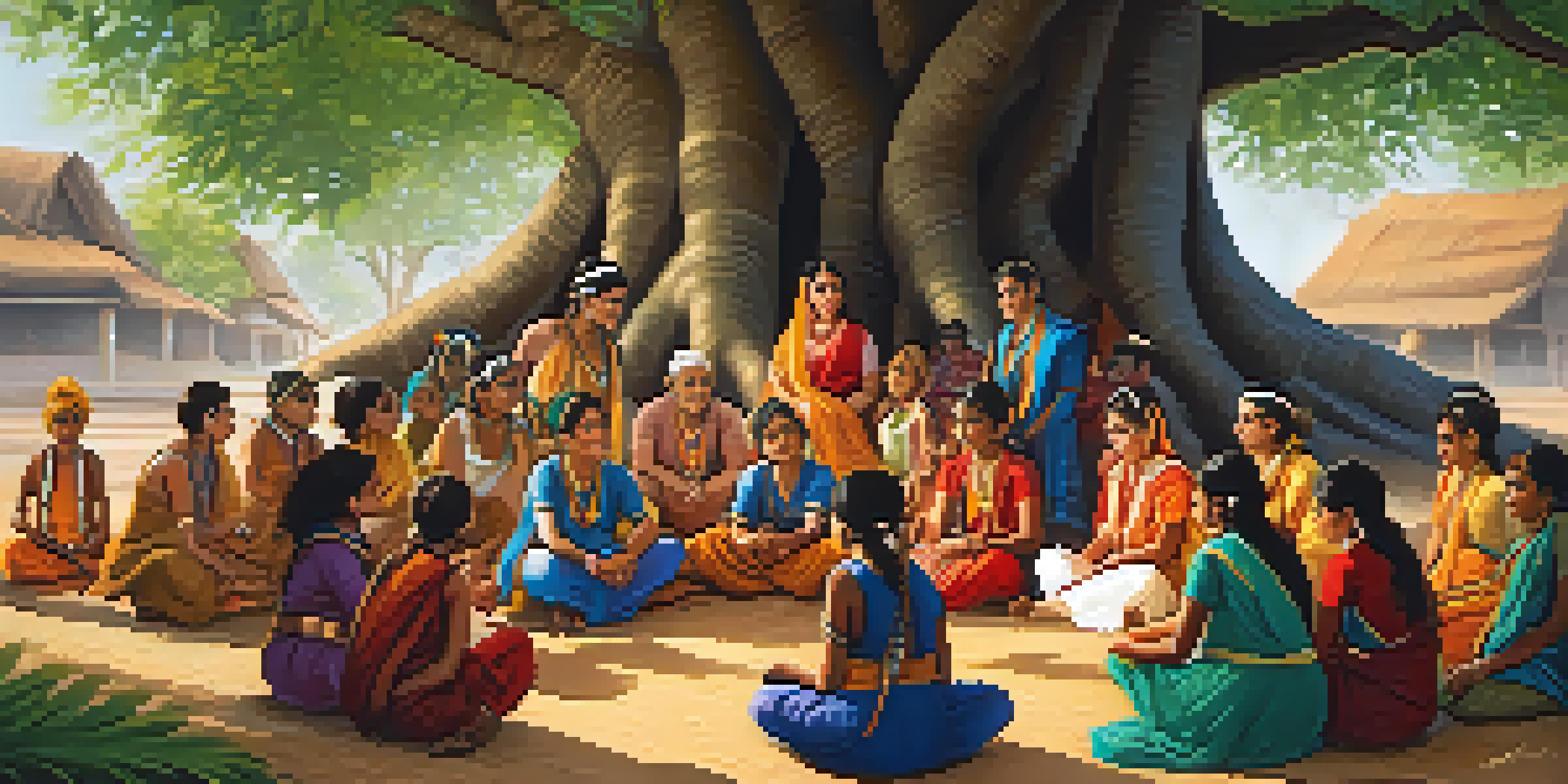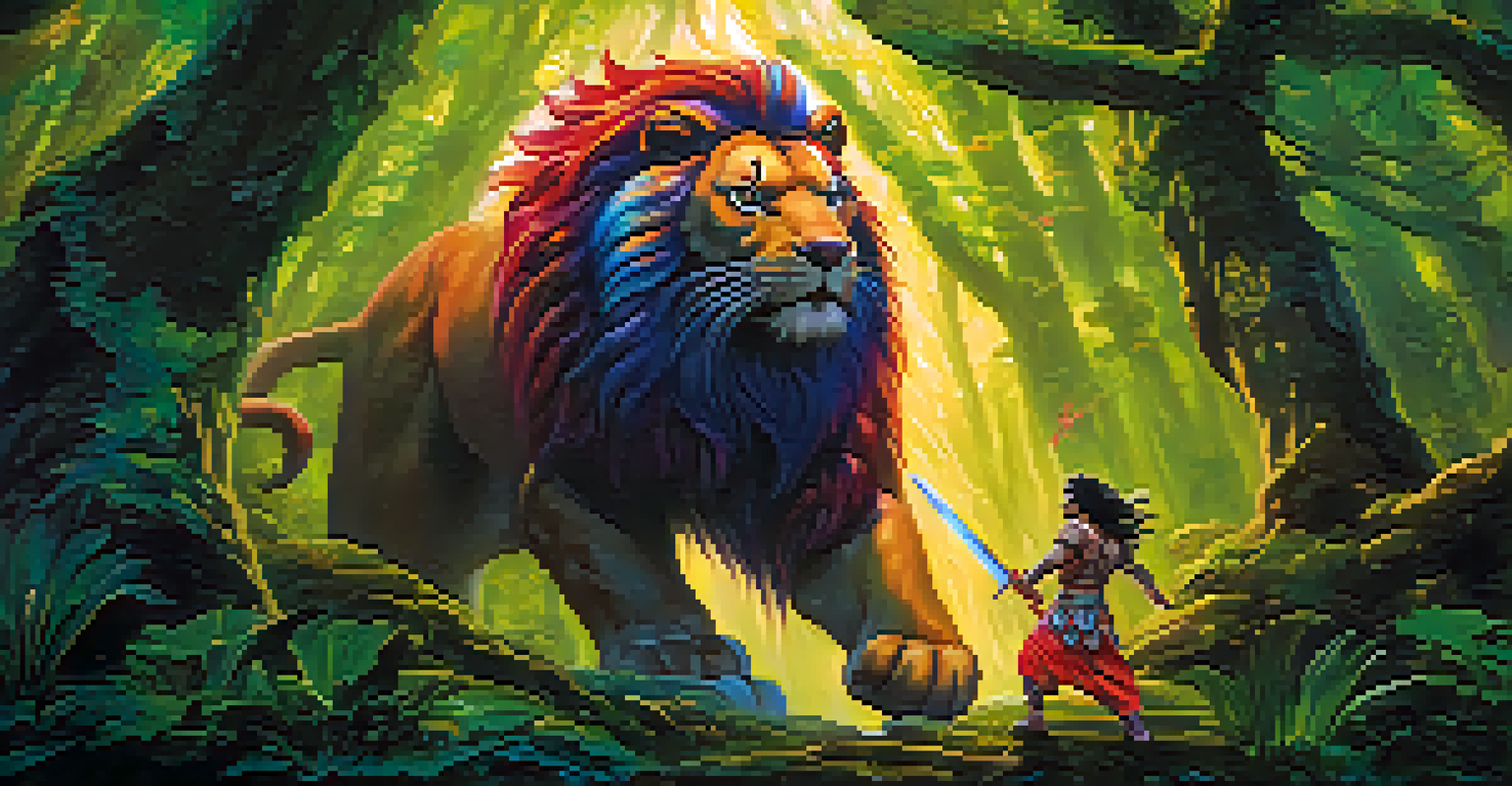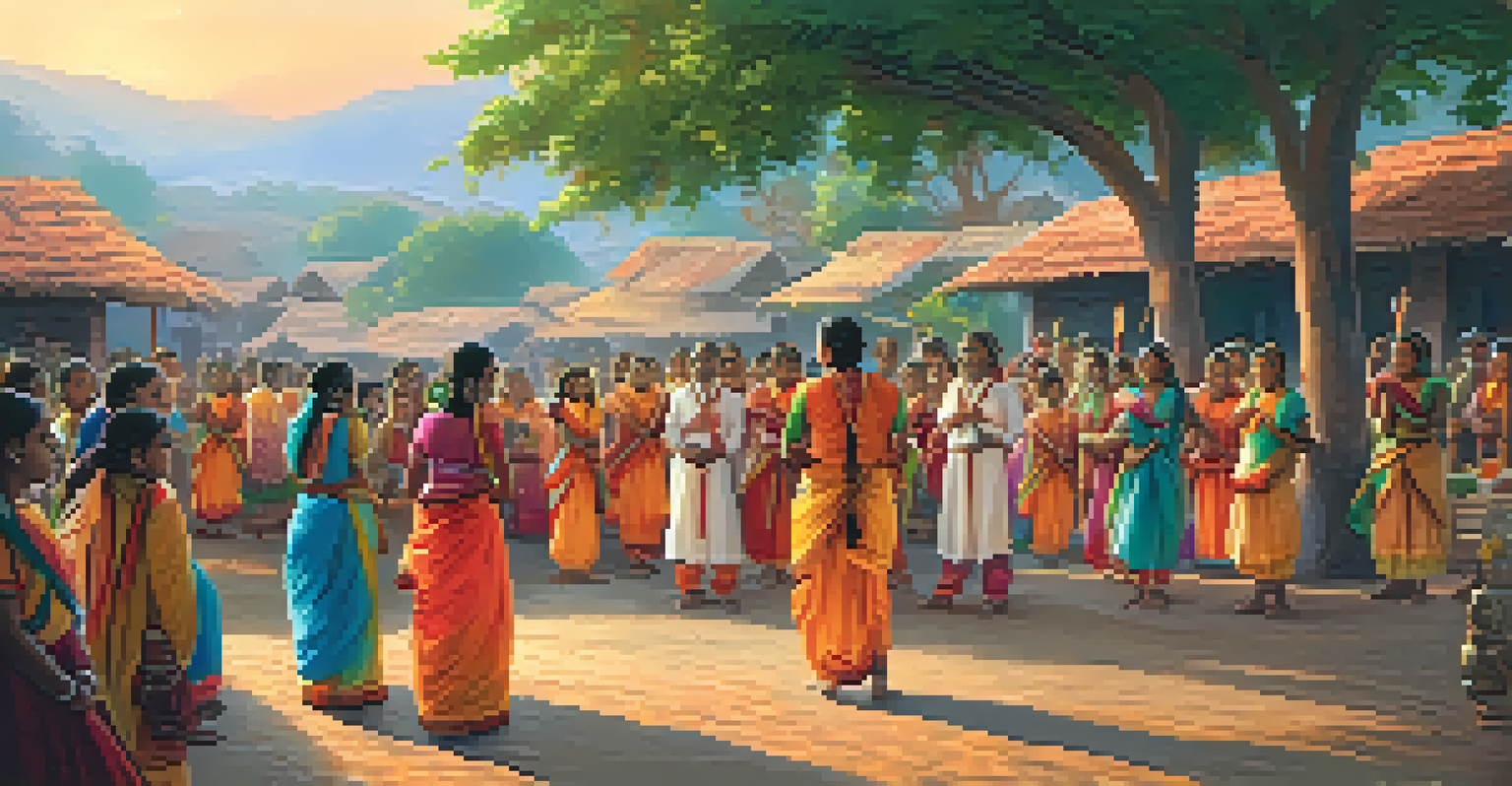Folklore of India: Myths and Legends That Shape Culture

The Essence of Indian Folklore: A Cultural Tapestry
Indian folklore serves as a vibrant tapestry woven from age-old myths and legends, reflecting the diverse cultures within the country. It encompasses stories passed down through generations, often revealing moral lessons, historical events, and spiritual beliefs. These tales, whether originating from rural villages or urban centers, offer insights into the values and traditions that shape Indian society.
Folklore is the living expression of the beliefs, values, and experiences of a community.
At its core, folklore is not just entertainment; it's a way of preserving history and identity. For instance, the stories of local deities and heroes often illustrate the triumph of good over evil, reinforcing community bonds. By sharing these narratives, people connect with their heritage, ensuring that the wisdom of the past continues to resonate in the present.
From the grand epics like the Mahabharata to regional tales of local gods, the essence of Indian folklore lies in its ability to adapt and evolve. Each storytelling session is not merely a recounting of events but a communal experience that brings people together, fostering a sense of belonging and continuity.
The Influence of Religion on Indian Myths and Legends
Religion plays a pivotal role in shaping the folklore of India, with Hinduism, Buddhism, Jainism, and Islam contributing rich narratives. Myths often intertwine with religious beliefs, creating a complex web of stories that serve both spiritual and cultural purposes. For example, the tales of Lord Krishna, filled with divine mischief and profound wisdom, are celebrated not only during festivals but also as moral guides in daily life.

These legends often depict the struggles between divine forces and evil, providing a framework for understanding life's challenges. The Ramayana and Mahabharata, two of the most significant epics, explore themes of duty, righteousness, and sacrifice, resonating deeply with the values held by many Indians. Such stories not only educate but also inspire individuals to navigate their personal journeys.
Folklore: A Cultural Preserver
Indian folklore serves as a vibrant tapestry that preserves history, identity, and moral lessons through age-old stories.
Moreover, local deities and folk saints emerge from various regions, each with their own unique stories that reflect local customs and beliefs. This diversity highlights the rich tapestry of religious influences on Indian folklore, making it a dynamic part of the country's cultural identity.
Folk Tales and Their Role in Community Life
Folk tales serve as the heartbeat of community life in India, often narrated during gatherings, festivals, and rituals. These stories are more than just entertainment; they are vital in passing down traditions and cultural values from one generation to the next. For instance, the tales of wise elders and clever animals often impart lessons on morality and ethics, reinforcing societal norms.
The stories we tell reflect who we are, and folklore helps us understand our place in the world.
In many communities, storytelling is an art form that brings people together, creating a shared experience that fosters unity. Elders, acting as the keepers of these stories, play a crucial role in maintaining cultural continuity, as they share their wisdom with younger generations. This oral tradition strengthens familial and communal bonds, ensuring that everyone feels connected to their roots.
Furthermore, folk tales often reflect the struggles and triumphs of local communities, addressing real-life issues through allegory and metaphor. By engaging with these narratives, individuals find comfort and understanding in their shared experiences, highlighting the significance of folklore in everyday life.
Regional Variations: Unique Folklore Across India
India's vast diversity results in a rich mosaic of regional folklore, with each area boasting its own unique stories and traditions. From the snow-capped mountains of the North to the sun-kissed shores of the South, every region has tales that reflect its environment, culture, and history. For example, the folk tales of the Punjab often celebrate valor and romance, while those from Rajasthan highlight bravery and adventure.
These regional stories not only entertain but also preserve local languages and dialects, as they are often told in the vernacular. This linguistic diversity enhances the richness of folklore, allowing communities to express their identities through storytelling. Festivals and local celebrations frequently incorporate these tales, further embedding them into the cultural fabric of the region.
Religion Shapes Indian Myths
Religious beliefs significantly influence Indian folklore, intertwining myths with cultural narratives that guide moral values and societal norms.
Moreover, cross-regional exchanges have led to the adaptation of folklore, where stories evolve and take on new meanings. This fluidity showcases the dynamic nature of Indian culture, as narratives travel and transform, creating a blend of influences that enrich the collective understanding of folklore.
The Role of Folklore in Preserving Cultural Heritage
Folklore plays a crucial role in preserving the cultural heritage of India, acting as a repository of knowledge and traditions. As globalization increases, these stories serve as a reminder of the values, customs, and lifestyles that are intrinsic to various communities. By sharing folklore, individuals reaffirm their cultural identity, ensuring that it remains relevant in a rapidly changing world.
In many cases, folklore is used in educational settings to teach children about their history, ethics, and social responsibilities. Schools and community centers often organize storytelling sessions, making learning interactive and enjoyable. This approach not only engages young minds but also instills a sense of pride in their heritage.
Additionally, folklore has found its way into art, literature, and performances, further solidifying its importance in cultural preservation. Traditional dances, dramas, and visual arts often draw inspiration from these narratives, keeping them alive and accessible to future generations.
Folklore and Its Connection to Modern Indian Literature
Modern Indian literature has increasingly drawn inspiration from folklore, weaving traditional narratives into contemporary storytelling. Authors often revisit age-old myths and legends, reinterpreting them to address current societal issues and challenges. This blending of old and new not only keeps folklore alive but also makes it relevant for modern readers.
Books and stories that infuse folklore with contemporary themes encourage readers to explore their cultural roots while reflecting on present-day realities. For example, writers like Salman Rushdie and Arundhati Roy incorporate mythical elements into their narratives, blurring the lines between reality and fantasy. This approach enriches the literary landscape by providing depth and context to the characters and their journeys.
Regional Stories Reflect Diversity
India's diverse regions contribute unique folklore that not only entertains but also preserves local languages and cultural identities.
Moreover, adaptations of folklore into films and television series have brought these tales to a wider audience. By reimagining these stories in visual formats, filmmakers bridge the gap between tradition and modernity, ensuring that the essence of folklore continues to resonate with new generations.
The Future of Indian Folklore: Challenges and Opportunities
As society evolves, Indian folklore faces both challenges and opportunities in the modern world. The rapid pace of urbanization and technological advancement poses a risk of these traditional stories fading into obscurity. However, this same technology offers platforms for sharing and preserving folklore, making it accessible to a global audience.
Digital storytelling, social media, and online platforms have become crucial tools for folklorists and storytellers. By utilizing these mediums, they can reach a broader audience and keep the narratives alive in the digital age. Initiatives to document and promote local folklore are also gaining momentum, ensuring that diverse voices are heard and celebrated.

Ultimately, the future of Indian folklore depends on the collective efforts of communities to adapt and innovate while honoring their traditions. By embracing both heritage and modernity, folklore can continue to thrive, providing valuable lessons and insights for generations to come.